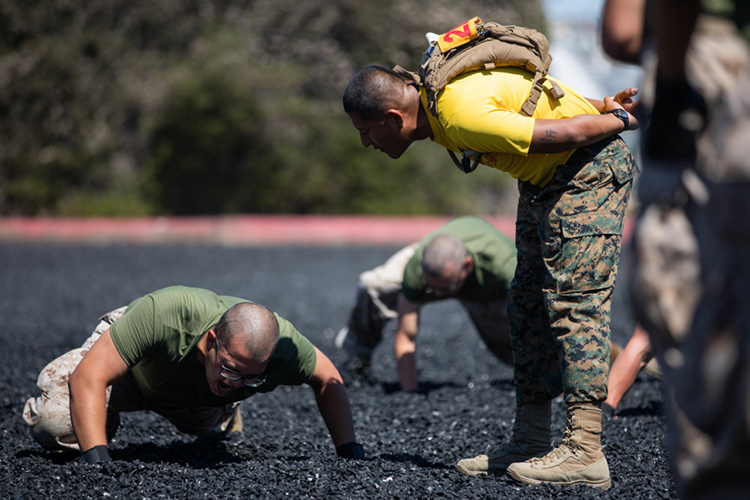Surveillance snapshot: Illness and injury burdens, recruit trainees, U.S. Armed Forces, 2020
 A U.S. Marine Corps drill instructor with Golf Company, 2nd Recruit Training Battalion, motivates a recruit during a Marine Corps Martial Arts Program (MCMAP) training session at Marine Corps Recruit Depot, San Diego, Aug. 2, 2021. The drill instructors ensured recruits conducted the techniques safely and effectively during the training session. (U.S. Marine Corps photo by Cpl. Zachary T. Beatty)
A U.S. Marine Corps drill instructor with Golf Company, 2nd Recruit Training Battalion, motivates a recruit during a Marine Corps Martial Arts Program (MCMAP) training session at Marine Corps Recruit Depot, San Diego, Aug. 2, 2021. The drill instructors ensured recruits conducted the techniques safely and effectively during the training session. (U.S. Marine Corps photo by Cpl. Zachary T. Beatty)
You also may be interested in...
Article
Feb 1, 2019
Human adenoviruses (HAdVs) are known to cause respiratory illness outbreaks at basic military training (BMT) sites. HAdV type-4 and -7 vaccines are routinely administered at enlisted BMT sites, but not at military academies. During Aug.–Sept. 2016, U.S. Naval Academy clinical staff noted an increase in students presenting with acute respiratory ...
Article
Feb 1, 2019
The MSMR has been publishing the results of surveillance studies of malaria since 1995. The standard MSMR case definition uses Medical Event Reports and records of hospitalizations in counting cases of malaria. This report summarizes the performance of the standard MSMR case definition in estimating incident cases of malaria from 2015 through 2017. ...
Article
Dec 1, 2018
This analysis describes the incidence and prevalence of five thyroid disorders (goiter, thyrotoxicosis, primary/not otherwise specified [NOS] hypothyroidism, thyroiditis, and other disorders of the thyroid) among active component service members between 2008 and 2017. During the 10-year surveillance period, the most common incident thyroid disorder ...
Article
Dec 1, 2018
This report uses ICD-9 and ICD-10 codes (277.7 and E88.81, respectively) for the metabolic syndrome (MetS) to summarize trends in the incidence and prevalence of this condition among active component members of the U.S. Armed Forces between 2002 and 2017. During this period, the crude overall incidence rate of MetS was 7.5 cases per 100,000 person ...
Article
Dec 1, 2018
During 2002–2017, the most common incident adrenal gland disorder among male and female service members was adrenal insufficiency and the least common was adrenomedullary hyperfunction. Adrenal insufficiency was diagnosed among 267 females (crude overall incidence rate: 8.2 cases per 100,000 person-years [p-yrs]) and 729 males (3.9 per 100,000 p-yrs). ...
You are leaving Health.mil
The appearance of hyperlinks does not constitute endorsement by the Department of Defense of non-U.S. Government sites or the information, products, or services contained therein. Although the Defense Health Agency may or may not use these sites as additional distribution channels for Department of Defense information, it does not exercise editorial control over all of the information that you may find at these locations. Such links are provided consistent with the stated purpose of this website.
You are leaving Health.mil
View the external links disclaimer.
Last Updated: August 18, 2021